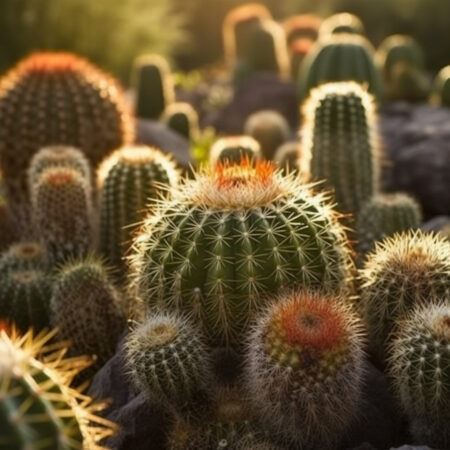Key Takeaways:
- Cacti have unique adaptations to survive in arid climates, including storing water in their fleshy stems and carrying out efficient photosynthesis through CAM photosynthesis.
- Cacti can expand and contract to maximize water absorption and have thick waxy coatings and spines to reduce water loss and protect against heat.
- Global warming can negatively impact cactus growth through increased temperatures, elevated CO2 levels, and changing rainfall patterns.
- Choosing the right cactus species, optimizing sunlight exposure, and practicing controlled watering are essential for cactus care in a warming climate.
- Conservation efforts, such as protected areas and botanical gardens, are crucial for preserving cactus diversity.
- Individual actions, such as conserving energy and supporting sustainable practices, can contribute to protecting cacti.
The Basics of Cactus Growth
Understanding the Anatomy of a Cactus
Cacti are unique plants that have adapted to survive in arid climates with limited water availability. To understand the impact of global warming on cactus growth patterns, it’s important to first grasp the anatomy of these fascinating plants. Cacti have thick, fleshy stems that store water, allowing them to withstand long periods of drought. Their leaves are reduced to spines, which serve to minimize water loss and protect the plant from herbivores. Additionally, cacti have shallow roots that spread out horizontally to capture as much rainwater as possible.
The Role of Photosynthesis in Cactus Growth
Photosynthesis is a vital process for cactus growth. Cacti have specialized adaptations that enable them to carry out photosynthesis efficiently, even in harsh desert conditions. Unlike most plants, cacti perform a modified form of photosynthesis called CAM (Crassulacean Acid Metabolism) photosynthesis. They open their stomata, small openings on the surface of their stems, during the night to collect carbon dioxide and minimize water loss. This stored carbon dioxide is then used for photosynthesis during the day when the stomata are closed to prevent water loss. By adapting their photosynthetic process, cacti can conserve water and thrive in environments with limited rainfall.
Exploring the Unique Survival Adaptations of Cacti
Cacti have evolved fascinating survival adaptations to thrive in their native habitats. One of the most notable adaptations is their ability to expand and contract to maximize water absorption. When water is available, cacti rapidly expand to store as much water as possible. As water becomes scarce, the cactus shrinks, reducing its surface area and minimizing water loss. Additionally, cacti have a thick waxy coating on their stems that helps reduce water evaporation. Some cacti also have spines that cast a shadow on the plant, reducing the amount of direct sunlight and heat they are exposed to.
The Impact of Global Warming on Cactus Growth
Examining the Relationship Between Temperature and Cactus Growth
Global warming has led to a rise in average temperatures worldwide, which can have significant implications for cactus growth patterns. Cacti are adapted to thrive in hot and dry environments, but increased temperatures can push them beyond their tolerance limits. High temperatures can cause excessive water loss through transpiration, leading to dehydration and stunted growth. It can also disrupt the delicate balance of carbon dioxide intake during the night and hinder the cactus’s ability to carry out efficient photosynthesis. Furthermore, extreme heat events can result in heat stress and damage the cellular structure of cacti, impacting their overall growth and survival.
How Does Increased CO2 Levels Affect Cactus Development?
Another consequence of global warming is the rising levels of carbon dioxide (CO2) in the atmosphere. While increased CO2 can initially stimulate plant growth, prolonged exposure to elevated CO2 levels can have negative effects. Cacti, like other plants, have an optimal range of CO2 concentrations at which they can effectively carry out photosynthesis. When CO2 levels exceed this threshold, cacti may experience reduced photosynthetic efficiency and nutrient imbalances, negatively impacting their growth and overall health. Additionally, elevated CO2 levels can alter the interactions between cacti and other organisms, such as pollinators and herbivores, which can further disrupt their growth and reproductive success.
The Consequences of Changing Rainfall Patterns on Cactus Habitats
Global warming is also altering rainfall patterns, with many regions experiencing increased frequency and intensity of droughts. Cacti rely on irregular rainfall events to survive and reproduce. Changes in precipitation patterns, such as prolonged droughts or intense rainfall followed by long dry spells, can disrupt the delicate balance of water availability that cacti depend on. Extended droughts can lead to water scarcity, depleting the cactus’s water reserves and hindering its growth. On the other hand, intense rainfall events can cause waterlogging, which can damage the cactus’s shallow roots and lead to root rot and disease.
Adapting Cactus Care for Changing Climate
Choosing the Right Cactus Species for Your Location
As global warming continues to impact cactus growth patterns, it’s essential to choose cactus species that can thrive in your specific location. Different cactus species have varying temperature and water requirements. Research the natural habitat of the cactus species you wish to grow and select those that are better suited to the anticipated changes in temperature and rainfall. Opting for native species can also contribute to the preservation of local biodiversity and ensure the cacti are adapted to the local climate.
Optimizing Sunlight Exposure for Healthy Cactus Growth
Sunlight is crucial for cactus growth, but excessive heat and intense sunlight can harm these plants. As temperatures rise due to global warming, it’s important to provide cacti with the right amount of sunlight exposure. Consider providing partial shade or using shade cloths to protect cacti from scorching sun rays during the hottest parts of the day. Monitoring the sunlight needs of different cactus species and adjusting their exposure accordingly can help maintain their health and promote optimal growth.
Best Watering Practices for Cacti in a Warming Climate
Watering cacti appropriately is essential for their growth and survival, especially in a warming climate. While it may seem counterintuitive, it’s important to avoid overwatering cacti. Excess water can lead to root rot and promote the growth of fungal infections. Instead, practice controlled watering by allowing the soil to dry out between watering sessions. When watering, provide sufficient water to thoroughly soak the soil, ensuring proper root hydration. Additionally, collecting rainwater for watering can minimize water waste and provide a natural source of hydration for your cacti.

Strategies for Preserving Cactus Diversity
The Importance of Conservation Efforts for Threatened Cactus Species
With the increasing threat of global warming on cactus growth patterns, it’s vital to prioritize conservation efforts for threatened cactus species. Habitat destruction, illegal collecting, and climate change have put many cactus species at risk of extinction. Conservation initiatives, such as protected areas, habitat restoration, and seed banks, can help preserve the genetic diversity of cacti and ensure their survival for future generations. Supporting and participating in these efforts, whether through volunteering or donations, can make a tangible difference in the preservation of cacti diversity.
The Role of Botanical Gardens in Cactus Preservation
Botanical gardens play a crucial role in cactus preservation and research. These institutions often have specialized collections of cacti, including rare and endangered species. Botanical gardens provide a safe haven for these plants, allowing researchers to study them and implement conservation measures. They also educate the public about the importance of cacti and their role in ecosystems. Visiting and supporting botanical gardens can contribute to their conservation efforts and help raise awareness about the plight of cacti in the face of global warming.
How Individuals Can Make a Difference in Protecting Cacti
While the task of combating global warming and preserving cacti diversity may seem daunting, individuals can make a difference through their everyday choices and actions. Conserving energy by reducing electricity consumption, using renewable energy sources, and adopting sustainable practices can help mitigate the impacts of climate change. Additionally, supporting local farmers and purchasing sustainably grown products can contribute to reducing habitat destruction and promoting biodiversity. Raising awareness about the importance of cacti and engaging in community initiatives and conservation projects can also play a significant role in protecting these unique plants.
By understanding the basics of cactus growth, the impact of global warming on cactus growth, adapting cactus care for a changing climate, and strategies for preserving cactus diversity, we can actively contribute to the protection and conservation of these remarkable plants. With collective effort and informed action, we can safeguard cacti and their unique growth patterns for generations to come.
FAQ
Question: What are some unique adaptations of cacti to survive in arid climates?
Cacti have thick, fleshy stems to store water, shallow roots to capture rainwater, and spines to minimize water loss and protect against herbivores. They also have a thick waxy coating on their stems to reduce water evaporation.
Question: How do cacti carry out photosynthesis in harsh desert conditions?
Cacti perform CAM (Crassulacean Acid Metabolism) photosynthesis. They open their stomata at night to collect carbon dioxide and store it for photosynthesis during the day when the stomata are closed to prevent water loss. This adaptation helps them conserve water in arid environments.
Question: How does global warming impact cactus growth?
Global warming can negatively impact cactus growth through increased temperatures, elevated CO2 levels, and changing rainfall patterns. High temperatures can cause excessive water loss, disrupt carbon dioxide intake, and damage the cellular structure of cacti. Elevated CO2 levels can reduce photosynthetic efficiency, and changes in rainfall patterns can lead to water scarcity or waterlogging.
Question: What can be done to adapt cactus care for a changing climate?
To adapt cactus care for a changing climate, it is important to choose cactus species that are suited to the anticipated changes in temperature and rainfall. Providing the right amount of sunlight exposure and practicing controlled watering are also essential. Collecting rainwater for watering can minimize water waste.
Question: How can conservation efforts help preserve cactus diversity?
Conservation efforts such as protected areas, habitat restoration, and seed banks can help preserve cactus diversity. These initiatives protect cactus habitats, support the growth of endangered species, and ensure the survival of cacti for future generations.
Question: How do botanical gardens contribute to cactus preservation?
Botanical gardens play a vital role in cactus preservation by housing specialized collections of cacti, including rare and endangered species. They provide a safe environment for research, implement conservation measures, and educate the public about the importance of cacti and their role in ecosystems.
Question: How can individuals contribute to protecting cacti?
Individuals can make a difference by conserving energy, supporting sustainable practices, and raising awareness about the importance of cacti. Conserving energy helps mitigate climate change, supporting sustainable practices reduces habitat destruction, and raising awareness encourages conservation initiatives and projects.
Question: How can understanding cactus growth patterns help protect and conserve cacti?
Understanding cactus growth patterns allows us to make informed decisions about cactus care and contribute to the protection and conservation of these remarkable plants. With collective effort and informed action, we can safeguard cacti and preserve their unique growth patterns for future generations.




Comments